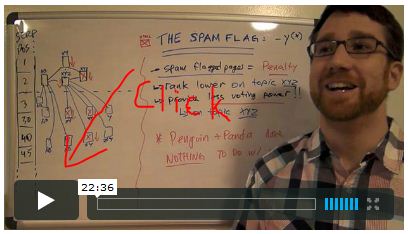 If you read my blog post on how to thrive despite Google panda and penguin updates, you will know where I stand when it comes to spam or questionable internet marketing practices. So I am not going to go in that direction again, but rather focus on what these recent Google algorithm updates have meant to my websites and ultimately my business.
If you read my blog post on how to thrive despite Google panda and penguin updates, you will know where I stand when it comes to spam or questionable internet marketing practices. So I am not going to go in that direction again, but rather focus on what these recent Google algorithm updates have meant to my websites and ultimately my business.
It was my finding and also my conclusion that a lot of sites (some of mine included) did not drop in the Google search results because of bad content on the sites itself – or because of bad backlinks pointing to them, but rather because: the backlinks that originally forced these sites to rank high (good thing) were coming from sites that had displeasable content on them (bad thing). I am referring to “content” in a very generic sense here because these days it could be anything, but from my findings, the Google Panda and Penguin algorithm updates were created to sniff out sites that lacked unique quality content (sites that more or less had spammy or junkie content on them).
As soon as Google determined that a site consisted of useless content, it took away a lot (if not all) of it’s ranking power (linkjuice). In fact, a lot of websites even got completely de-indexed. Which meant that not only would the site in question drop in rankings, but all the sites it linked to would also drop in ranking (assuming this site used to help these other sites rank higher).
I was getting ready to do a video on this for you to try and explain everything in little more detail, but then I was asked to watch a short presentation of the SENuke guys and was happy to see that my findings were similar to theirs. I figured instead of trying to explain this all myself, I’d let them do the talking:
Watch the video (it will open in a new window):

What is your conclusion on the matter? Any interesting case-studies or findings of your own in regards to the recent updates? I would love to hear from you!
Also, I got a handful of super exciting projects on the go right now that I am hoping to come out with in June and July that are more or less geared towards stabilizing our site’s rankings on the search engines. I think you will love them, so, keep an eye out for that.

Hi Konrad. How can we find out which sites google penalized or did not like content on them so that we don’t use them for backlinking?
I think it would be hard to do unless you already had some existing data on the site (ex: where it ranks for certain keywords, etc).
As a good rule of thumb though, you would want to take a look at the content on the site to see if it is something you would want your site to be associated with. If the content is crappy and more importantly, not up to Google’s standards, then you’d be better off not to get backlinks from it.
Just my quick 5 cents… I hope that makes sense.
Ok, thanks. So I watched the video. I’m confused. So does that mean we should not use the all-in-one-seo plugin to put in our title tags, description and keywords?
I honestly don’t think that is the case. I will keep using the All-In-One-SEO plugin until my findings suggest that it actually hurts my rankings.
I think what he is more getting at is: stuffing keywords in image tags, etc (beyond of what the plugin already does).
In my own findings, it did not have so much to do with the hidden tags itself as the actual visible content. Meaning I did not look at tags themselves. I can’t really confirm his findings in this case.